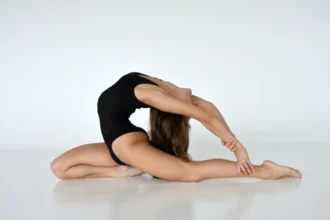In the world of gymnastics, mental blocks can be particularly devastating. One of the most feared phenomena in the sport is known as “the twisties.” It is a dreaded phenomenon that can suddenly derail even the most skilled and experienced athlete.
What are the Twisties?
In gymnastics, the twisties refer to a gymnast’s sudden inability to execute twists and rotations while in the air, leading to disorientation, loss of spatial awareness, and potentially dangerous landings. As legendary gymnast Simone Biles describes it, “It’s basically like your mind and your body is at a disconnect.”
A gymnast suffering from the twisties may find themselves unable to complete the required number of rotations or land safely, even on skills they have performed countless times before.
The sensation has been compared to suddenly forgetting how to drive a car – a terrifying experience for a gymnast who relies on precise body control and spatial awareness.
During the twisties, gymnasts lose their sense of where they are in the air relative to the ground. This spatial disorientation can lead to:
- Loss of muscle memory
- Inability to control their body as they normally would
- Difficulty completing skills they’ve performed countless times before
- Increased risk of injury due to improper landings
What Causes the Twisties?
Experts believe that psychological factors such as stress, anxiety, and pressure play a significant role. Biles attributes her experience with the twisties in Tokyo to the immense pressure she felt, saying, “It’s like the weight of the world on your shoulders.”
The potential contributing factors include:
- Stress and Psychological Factors: High-pressure situations, such as major competitions, can trigger the twisties. The weight of expectations and the desire to perform perfectly can overwhelm an athlete’s mental state.
- Fatigue: Physical and mental exhaustion can contribute to the onset of the twisties.
- Changes in Technique or Equipment: Alterations in training routines or equipment can sometimes disrupt a gymnast’s spatial awareness.
- Previous Injuries or Fear: The memory of past injuries or the fear of getting hurt can sometimes manifest as the twisties.
- Complexity of Skills: As gymnasts push the boundaries of difficulty, the increased complexity of skills may contribute to the likelihood of experiencing the twisties.
Essentially, anything that disrupts a gymnast’s mental state or throws off their finely-tuned proprioception (sense of body position and movement) can potentially trigger the twisties.
Recovering from the Twisties
Overcoming the twisties requires patience, support, and a gradual return to training. As Aimee Boorman, Simone Biles’ former coach, explained, the recovery time can vary: “Normally, when it would happen, we would go back to training, and we would stop doing the skills that were making her feel like she was in the twisties… It could take anywhere from two days to two weeks to recover.”
According to Aimee Boorman, Simone Biles’ former coach, when Biles experienced the twisties in the past, they would adjust their training approach.
This involved focusing on different skills that didn’t trigger the twisties, allowing Biles to gradually regain her confidence and spatial awareness. Boorman noted that the recovery process could vary in duration, ranging from a couple of days to a couple of weeks
The key strategies gymnasts use to recover from the twisties include:
- Simplifying skills: Gymnasts often go back to basics, reducing the difficulty of their skills and slowly working their way back up. They may practice into a foam pit for safety as they regain their bearings.
- Repetition: Repeatedly practicing skills in a safe, controlled environment helps gymnasts rebuild the mind-body connection and muscle memory. As Boorman described, they methodically work to retrain the skills causing issues.
- Mental preparation: Techniques like visualization, focusing on breathing, and positive self-talk can help gymnasts manage anxiety, build confidence, and mentally rehearse their skills.
- Therapy and support: For Biles, regular therapy sessions have been a crucial part of her training regimen in prioritizing her mental health and working through challenges like the twisties. She even attended therapy during the 2024 Paris Olympics.
- Patience and self-care: Recovery is individual and can’t be rushed. Taking the time to heal both mentally and physically is key. For Biles, this has also meant taking pride in her appearance to boost her morale and confidence.
By August 2023, over two years after her struggle with the twisties in Tokyo, Biles confirmed she had overcome the issue, stating: “I’m fine. I’m twisting again. No worries. All is good.” She went on to have a triumphant performance at the 2024 Paris Olympics.
Suggestions For Gymnasts
Here are some suggestions for gymnasts dealing with the twisties, based on the information provided:
- Don’t push through it: If you start experiencing the twisties, it’s essential to listen to your mind and body. Avoid attempting skills that trigger disorientation or loss of spatial awareness, as this could lead to injury. Instead, take a step back and allow yourself time to regroup.
- Communicate with your coach: Be open and honest with your coach about what you’re experiencing. Together, you can develop a plan to adjust your training and gradually work through the twisties at a pace that feels safe and manageable for you.
- Break skills down: When you’re ready to start retraining skills, break them down into smaller, more manageable components. Start with basic drills and progressions, and slowly build up to the full skill. This gradual approach can help you regain your confidence and mind-body connection.
- Practice self-care: Prioritize your overall well-being during this challenging time. Engage in activities that help you relax and reduce stress, such as yoga, meditation, or spending time with supportive friends and family. Ensure you’re getting enough rest, proper nutrition, and hydration to support both your physical and mental recovery.
- Be patient with yourself: Overcoming the twisties is a process that takes time. Avoid putting pressure on yourself to recover quickly, and instead, focus on making steady progress at a pace that feels comfortable for you.
While deeply challenging, the twisties are not insurmountable. With the right support, coping tools and training adjustments, gymnasts can recover and return to confidently soaring and twisting through the air.
As Biles’ experience illuminates, prioritizing mental health and finding that mind-body reconnection is at the core of the healing process.





